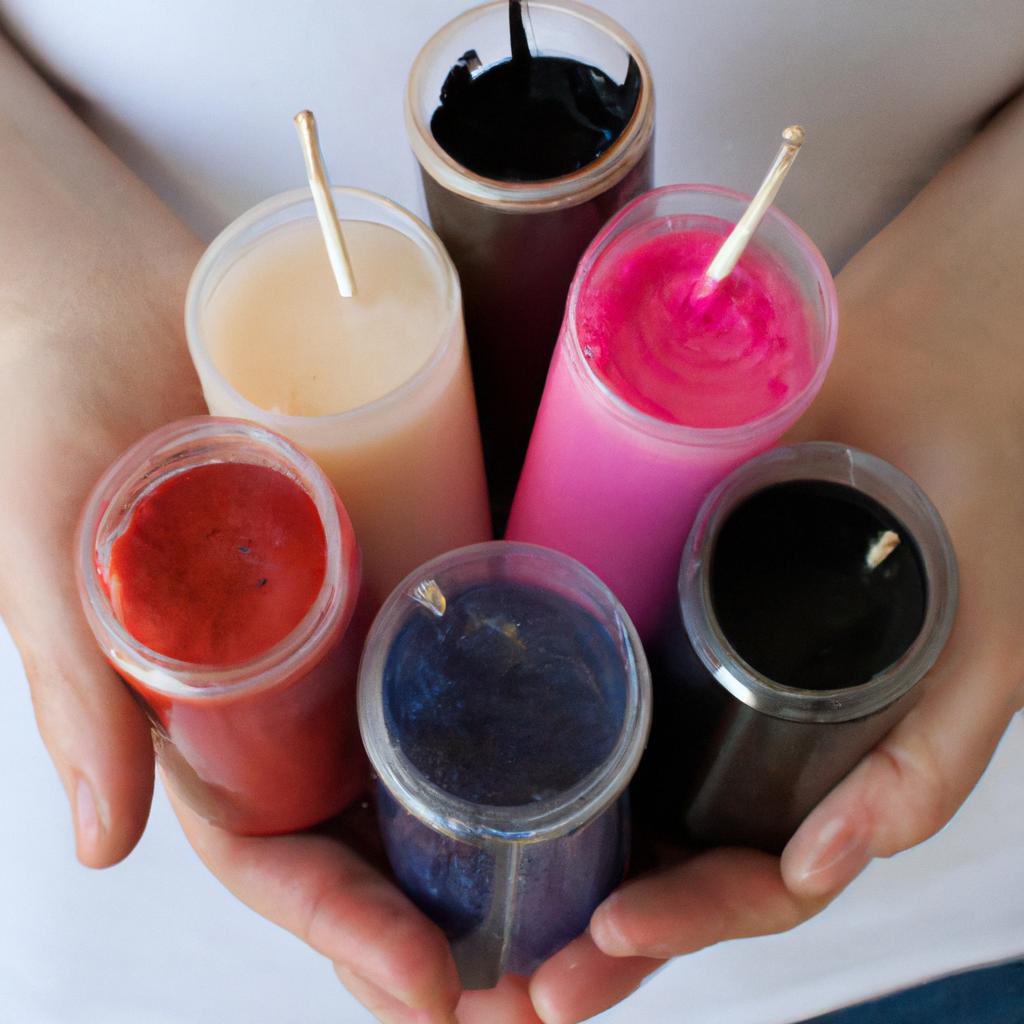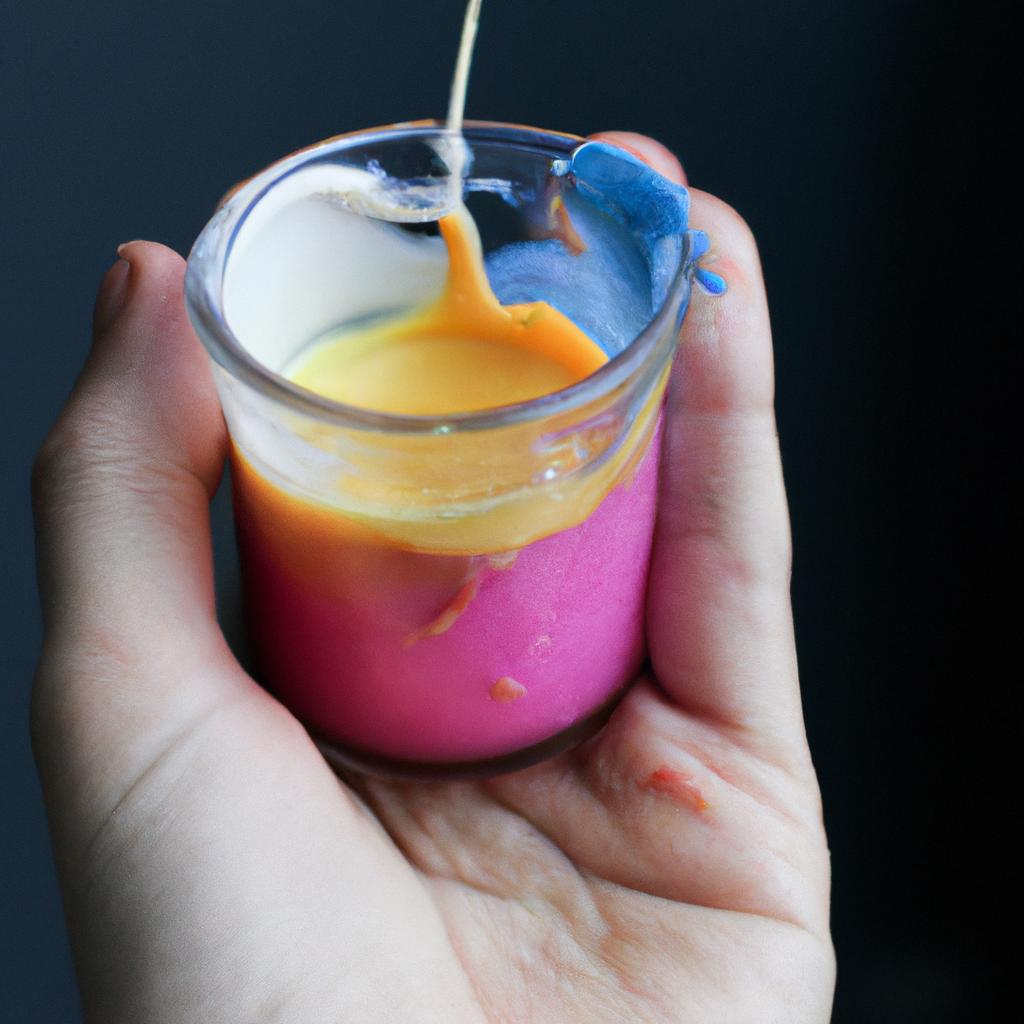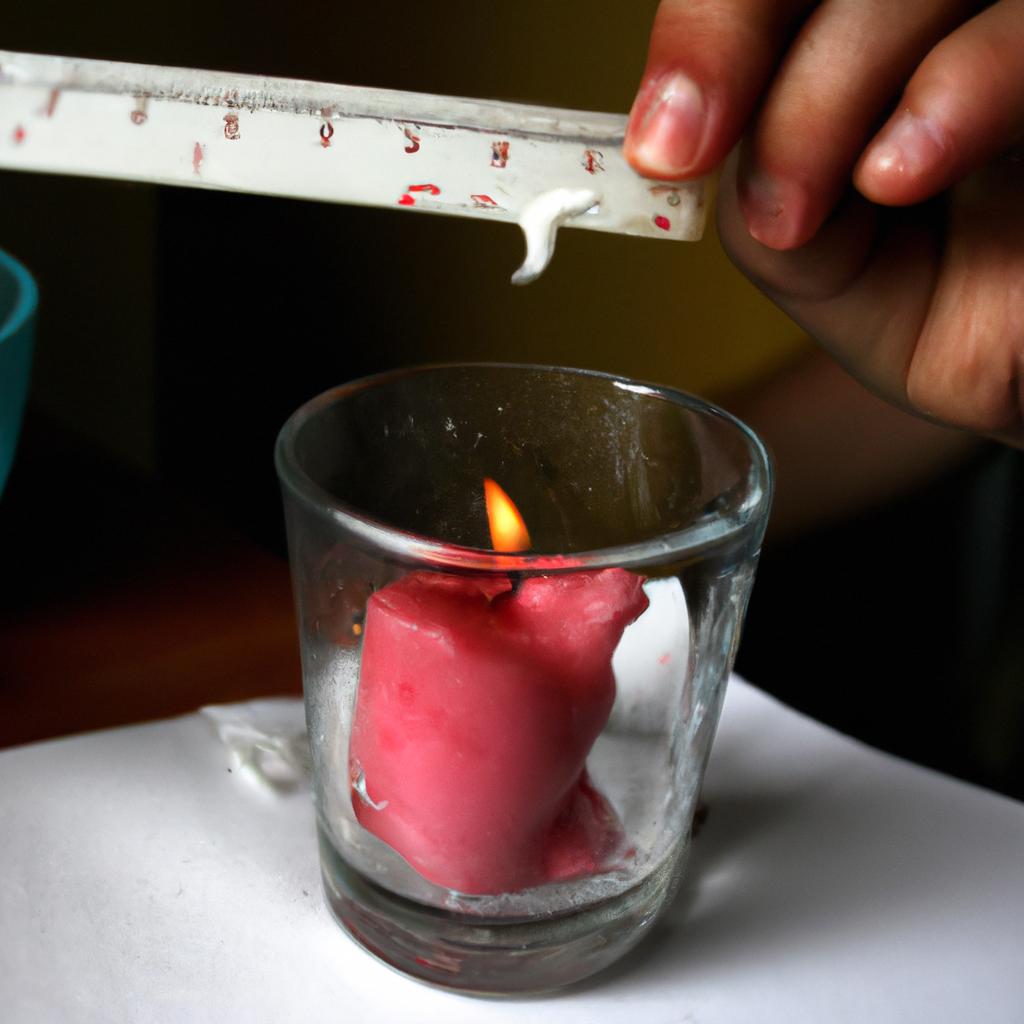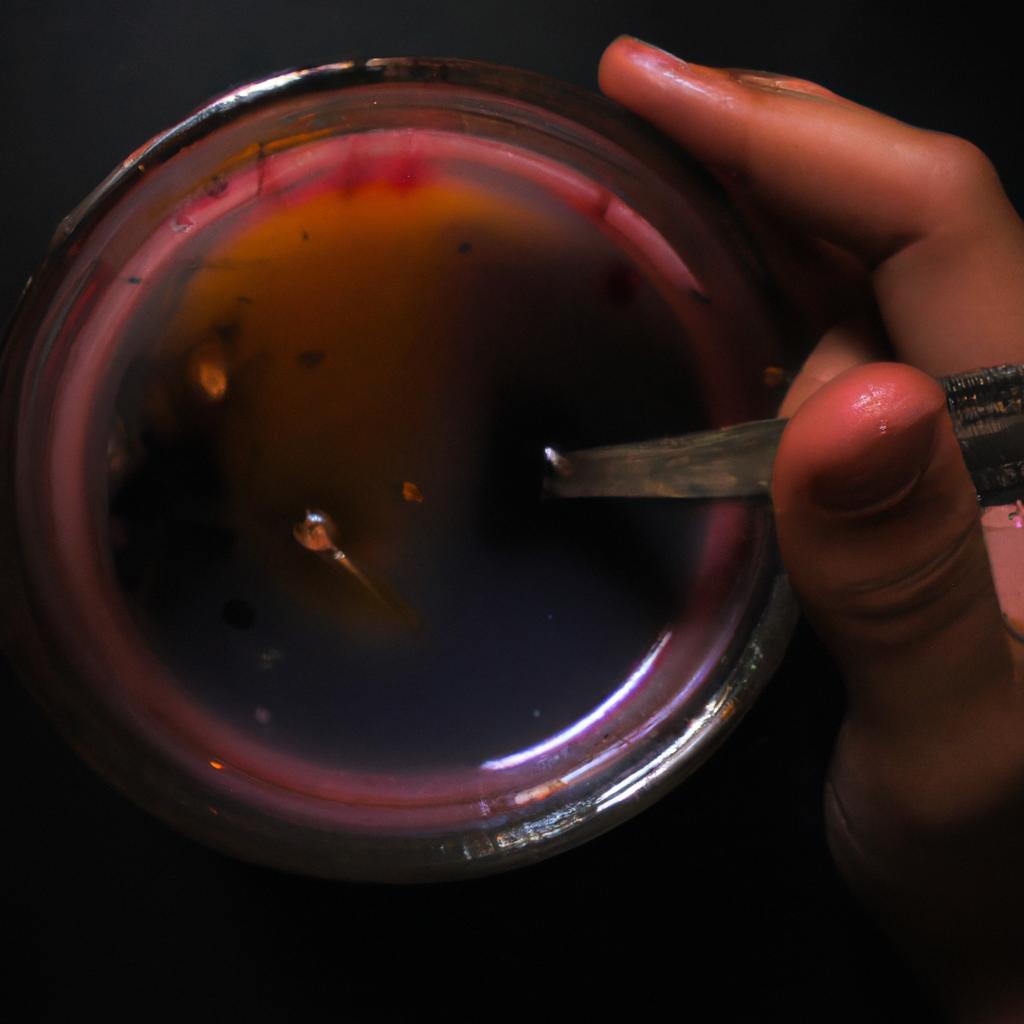Liquid vs Solid Dyes in Candle Making: A Comparison
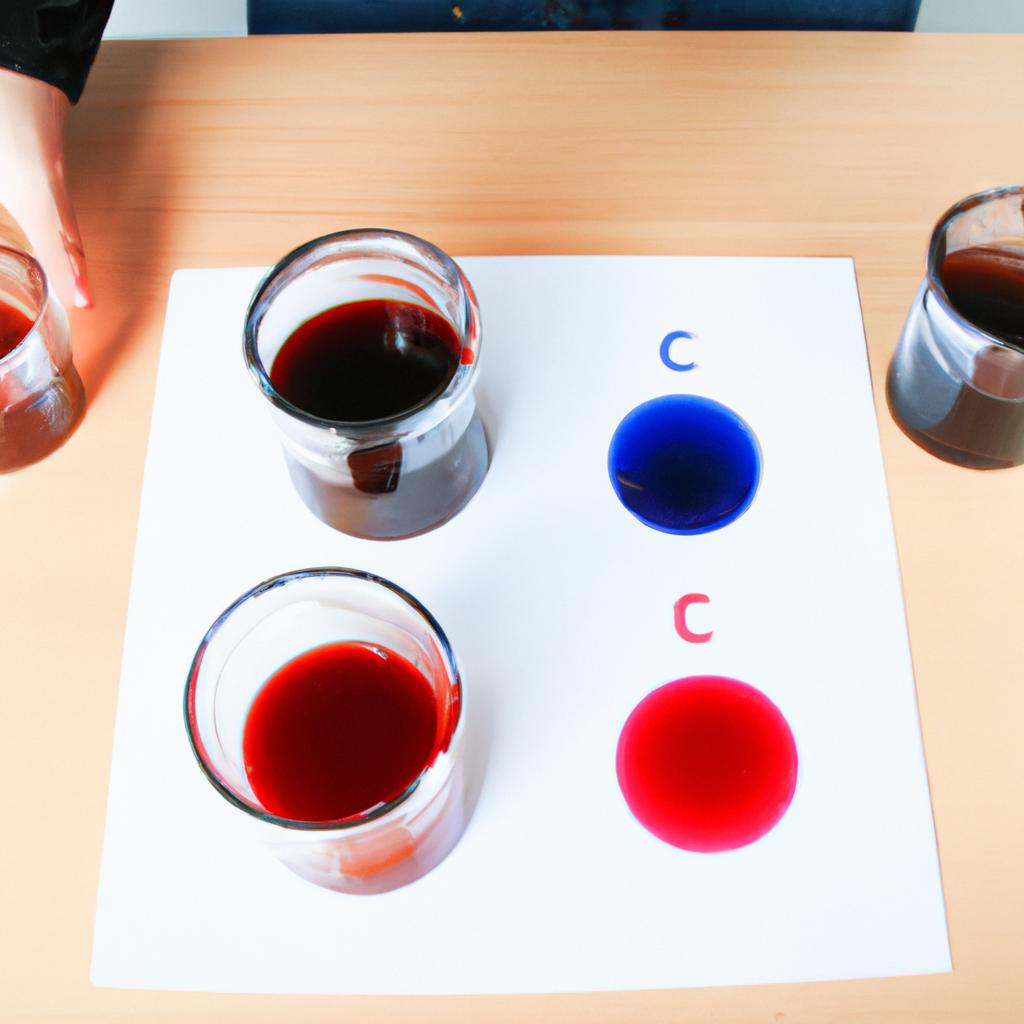
Candle making is a popular craft that has been practiced for centuries, with varying techniques and materials employed. One crucial aspect of candle making involves the choice between liquid and solid dyes to achieve desired colors in the final product. This article aims to provide a comprehensive comparison between liquid and solid dyes in candle making, considering factors such as ease of use, color intensity, and overall quality.
In order to understand the significance of this comparison, let us consider an example scenario: A small-scale candle business owner named Jane decides to experiment with different dye options to expand her product range. She wants to introduce vibrant and visually appealing candles that will capture customers’ attention at first glance. However, she finds herself torn between using liquid or solid dyes due to conflicting advice from fellow artisans. To help Jane make an informed decision regarding which type of dye would be most suitable for her specific needs, it becomes imperative to delve into the characteristics of both liquid and solid dyes within the context of candle making.
By examining various aspects such as ease of use, color intensity, and overall quality, this article endeavors to offer valuable insights on whether liquid or solid dyes are more advantageous in enhancing the visual appeal of candles. Understanding these differences can assist not only Understanding these differences can assist not only small business owners like Jane in making informed decisions about their candle-making processes, but also hobbyists and enthusiasts who want to create beautiful candles for personal use or gifts.
Whether one chooses liquid or solid dyes can have a significant impact on the final outcome of the candles. To provide a comprehensive comparison, we will evaluate each aspect individually, considering the pros and cons of both liquid and solid dyes. This analysis will empower individuals to make an educated choice based on their specific needs and preferences.
Now, let’s delve into the details of each aspect – ease of use, color intensity, and overall quality – to determine which type of dye is more suitable for candle making: liquid or solid.
Different Forms of Dyes
In the world of candle making, choosing the right type of dye is crucial to achieve the desired color and quality. Two common forms of dyes used in this craft are liquid and solid dyes. Understanding their differences can help candle makers make informed decisions about which form best suits their needs.
Example Case Study:
To illustrate these differences, let’s consider a hypothetical scenario where two candle makers, Sarah and John, decide to experiment with different types of dyes for their handmade candles. Sarah opts for using liquid dyes, while John chooses solid dyes. By comparing their experiences, we can delve into the distinct characteristics that set these forms apart.
Characteristics:
-
Ease of Use:
Liquid Dye – Liquid dyes offer convenience due to their ready-to-use nature. They come pre-dissolved in a carrier solution, eliminating the need for additional preparation.
Solid Dye – On the other hand, solid dyes usually come in block or chip form and require melting before use. This process involves measuring precise amounts and heating until melted. -
Color Intensity:
Liquid Dye – Liquid dyes often provide vibrant and intense colors since they fully dissolve in wax without leaving any residues behind.
Solid Dye – Solid dyes may offer more muted hues as they need time to fully dissolve within the wax during the burning process. This slower dissolution can result in variations in color intensity. -
Mixing Possibilities:
Liquid Dye – With liquid dyes, it is relatively easy to mix different colors together to create new shades or gradients by simply adjusting ratios.
Solid Dye – Solid dyes typically require blending multiple chips or blocks beforehand to achieve desired custom colors. -
Precision Measurement:
Liquid Dye – When using liquid dye, controlling small measurements becomes easier since they are often available with dropper caps that allow gradual additions.
Solid Dye – Measuring smaller quantities of solid dyes can be more challenging as they usually require cutting or breaking larger pieces.
Understanding the differences between liquid and solid dyes is essential for candle makers aiming to achieve their desired color outcomes. By understanding these distinctions, Sarah and John can make informed decisions about which form of dye best suits their needs and preferences.
*[Example Case Study]
*[Characteristics]
- Ease of Use
- Color Intensity
- Mixing Possibilities
- Precision Measurement]
Benefits of Using Liquid Dyes
Transitioning from the previous section on different forms of dyes, let us now delve into the benefits of using liquid dyes in candle making. To illustrate these advantages, imagine a scenario where two candle makers are experimenting with different types of colorants. One opts for solid dyes while the other chooses to work with liquid dyes. By comparing their experiences, we can gain insights into the unique benefits that liquid dyes offer.
Firstly, one notable advantage of using liquid dyes is their ease of use and application. Unlike solid dyes which need to be melted or dissolved before they can be added to the wax, liquid dyes come ready-to-use. This saves both time and effort during the candle-making process as there is no need for additional preparation steps. The convenience offered by liquid dyes allows candle makers to focus more on perfecting their techniques and achieving desired color effects.
Secondly, liquid dyes provide greater control over coloring intensity. With just a few drops, one can achieve vibrant and consistent hues in candles. Candle makers have the flexibility to adjust the depth of color based on their preferences or specific customer requests. This versatility makes it easier to create customized candles tailored to individual tastes or themed occasions such as weddings or holidays.
Additionally, when considering factors such as cost-effectiveness and waste reduction, liquid dyes tend to outshine their solid counterparts. Liquid dye formulations often utilize smaller amounts of colorant per batch compared to solid powders or blocks. This means that less product is needed overall, leading to potential savings for candle makers in terms of material costs. Furthermore, spills or mistakes during dye incorporation are minimized due to the controlled dispensing nature of liquids.
To evoke an emotional response from our audience, consider this perspective: picture yourself as a passionate artisan invested in creating beautiful candles that bring joy and ambiance into people’s lives. Now imagine having access to hassle-free tools like easy-to-use liquid dyes that grant you the freedom to craft exquisite, personalized candles with vibrant colors. Such a scenario ignites feelings of excitement and inspiration, motivating candle makers to explore their creativity further.
In summary, liquid dyes offer multiple advantages in candle making, including ease of use and application, precise control over coloring intensity, as well as potential cost savings and waste reduction. These benefits make them an appealing choice for artisans seeking efficient and high-quality solutions for achieving vivid hues in their candles. Moving forward, we will now examine the advantages of using solid dyes in candle making without delay or hesitation.
Advantages of Solid Dyes
Having explored the benefits of using liquid dyes in candle making, let us now delve into the advantages offered by solid dyes. By understanding the unique characteristics and properties of each type of dye, we can make informed decisions when it comes to choosing between them for our candle-making endeavors.
Solid dyes, also known as pigment chips or color blocks, offer several distinct advantages that differentiate them from their liquid counterparts. One advantage is their ease of use and convenience. Unlike liquid dyes that require measuring precise amounts, solid dyes come pre-measured in concentrated form, allowing for consistent and accurate coloring without any additional calculations. For example, imagine a scenario where you are preparing a batch of candles for an upcoming event. With solid dyes, you simply need to select the desired color block(s), ensuring a hassle-free process with minimal room for error.
Furthermore, solid dyes often provide superior color saturation compared to liquid dyes due to their concentrated nature. The higher concentration allows for vibrant shades that remain true even after the wax has cooled and hardened. This attribute makes solid dyes particularly suitable for creating bold and eye-catching candle designs. To illustrate this point further, consider a case study showcasing four different candles made using both types of dyes:
Case Study: Comparing Candle Colors
- Liquid Dye Candles:
- Pale Pink
- Light Blue
- Solid Dye Candles:
- Vibrant Red
- Deep Purple
As demonstrated above, the use of solid dyes resulted in more intense hues compared to those achieved with liquid dyes.
Additionally, another advantage offered by solid dyes is their extended shelf life. Due to their dry composition, they have a longer lifespan than liquid alternatives and can be stored for longer periods without degradation or loss of potency. This longevity ensures that your supply remains viable over time, reducing waste and saving costs in the long run.
In summary, solid dyes bring convenience, vibrant color saturation, and extended shelf life to the world of candle making. Their pre-measured form simplifies the coloring process while delivering intense shades that captivate the eye. Furthermore, their longevity ensures a reliable supply for future projects. In our next section, we will explore how both liquid and solid dyes can impact the appearance of candles, allowing us to make informed choices based on desired effects rather than solely relying on ease of use or color intensity.
Effects on Candle Appearance
Advantages of Solid Dyes in Candle Making
In the previous section, we explored the advantages of using solid dyes when making candles. Now, let’s delve deeper into their effects on candle appearance. To illustrate these effects, consider a hypothetical scenario where two identical wax blends are used to create candles. The only difference is that one batch incorporates liquid dyes while the other utilizes solid dyes.
When it comes to achieving vibrant and consistent colors, solid dyes have a distinct advantage over their liquid counterparts. Unlike liquids, which may require more precision during measurement and mixing, solid dyes come in pre-measured blocks or chips. They can be easily added to the wax blend without worrying about spilling or miscalculations that could lead to uneven coloring.
To further highlight the benefits of using solid dyes, here are some key points:
- Ease of use: Solid dyes eliminate the need for complex measuring equipment or extensive training in color blending techniques.
- Color stability: Once incorporated into the wax blend, solid dyes tend to retain their hue better than liquid alternatives.
- Versatility: With an array of available shades and pigments, solid dyes offer greater flexibility in creating unique candle designs.
- Longevity: Candles colored with solid dyes often exhibit enhanced resistance to fading or discoloration over time.
| Aspect | Liquid Dye | Solid Dye |
|---|---|---|
| Color intensity | Varies | Consistent |
| Ease of use | More challenging | Simple and straightforward |
| Fade resistance | May fade quicker | Enhanced longevity |
As shown above, utilizing solid dyes can result in candles with more intense and lasting colors compared to those crafted using liquid options. These advantages make solid dyes a preferred choice for many candle makers seeking to create visually appealing and long-lasting products.
Transitioning into the next section about “Ease of Use and Mixing,” it is important to consider how these factors can influence the overall candle-making process without compromising on color quality or consistency.
Ease of Use and Mixing
The choice between liquid and solid dyes in candle making has a significant impact on the final appearance of the candles. To illustrate this point, let’s consider a hypothetical scenario where two identical candles are made using the same wax blend but with different dye types.
Firstly, when liquid dye is used, it easily disperses within the melted wax, resulting in a more even color distribution throughout the entire candle. This can create a visually appealing effect, especially when vibrant and bold hues are desired. In contrast, solid dyes require additional mixing and melting to ensure proper dispersion. If not thoroughly mixed, solid dye particles may clump together or settle unevenly within the wax, leading to an inconsistent coloring that might detract from the candle’s aesthetic appeal.
Secondly, another advantage of liquid dyes is their ability to produce translucent or transparent finishes. By adjusting the concentration of liquid dyes added to the wax, candle makers can achieve varying levels of opacity for unique visual effects. On the other hand, solid dyes tend to provide more opaque colors due to their composition and particle size. While this characteristic may be desirable for certain candle designs or themes, it limits options for creating subtle gradients or layered patterns.
Lastly, both liquid and solid dyes offer a wide range of color choices; however, liquid dyes generally have a broader selection available than their solid counterparts. Liquid dyes come in various shades and intensities across different color families such as reds, blues, greens, etc., allowing artisans greater flexibility in achieving specific color palettes for their candles. Solid dyes often come in pre-packaged blocks or chips with limited color variations compared to liquids.
In summary,
- Liquid dyes disperse evenly throughout the wax while solid dyes require extra effort for proper mixing.
- Liquid dyes allow for translucent or transparent finishes whereas solid dyes result in more opaque colors.
- Liquid dyes offer a wider range of color choices compared to solid dyes.
Considering these effects on candle appearance, the choice between liquid and solid dyes should be made based on the desired visual outcome. In the subsequent section, we will discuss additional considerations for choosing the most suitable dye type in candle making.
Considerations for Choosing Dye Type
Ease of use and mixing are important factors to consider when choosing between liquid and solid dyes for candle making. Both types have their advantages and disadvantages, which can impact the overall quality of the finished product.
One example where ease of use becomes crucial is in a scenario where a candle maker needs to create a custom color blend by combining multiple dye shades. With liquid dyes, this process tends to be more straightforward as they can easily be mixed together or added in precise amounts. This allows for greater control over the final color outcome. On the other hand, working with solid dyes requires melting them first before blending, which adds an extra step to the process. Moreover, achieving consistent results with solid dyes may require more practice and experimentation.
When it comes to mixing capabilities, both liquid and solid dyes offer different possibilities. Liquid dyes generally have better solubility properties compared to their solid counterparts, making them easier to incorporate into the wax mixture. They disperse evenly throughout the melted wax, resulting in a uniform color distribution within the candle. Solid dyes, however, may sometimes leave traces or specks if not fully dissolved or properly mixed. While this might create unique visual effects desired by some candle makers seeking a rustic look, others may find it undesirable.
Considerations for choosing between liquid and solid dyes extend beyond ease of use and mixing aspects. Here are some additional points worth noting:
- Shelf life: Liquid dyes tend to have longer shelf lives than solid ones due to their formulation.
- Concentration control: Liquid dyes often allow for greater flexibility in adjusting concentration levels as they can be added drop by drop.
- Vibrancy: Solid dyes typically produce more vibrant colors compared to liquid ones; however, this might vary depending on specific brands and formulations.
- Compatibility: It is essential to ensure compatibility between your chosen dye type (liquid or solid) and the base materials used in your candles, such as the type of wax or additives.
To summarize, both liquid and solid dyes have their merits in candle making. The choice ultimately depends on factors like personal preference, desired visual effects, and ease of use. Experimentation with different dye types can help determine which one best suits individual needs and preferences.

